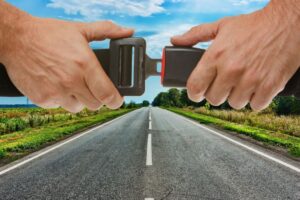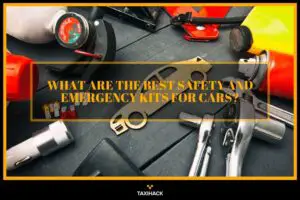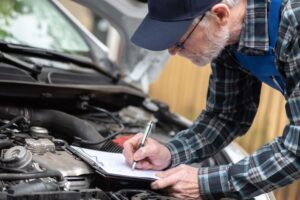Did you know that seat belts save around 15000 lives every year?
Yes, this is indeed true. They hold much more importance than one would think.
If you are wondering what does seat belt safety means and how it works?
Then seat belts are designed to restrain people inside vehicles during collisions.
They are a lifesaver and are being used on every vehicle since the 1970s to save lives.
Even though the public initially resisted them, they became mandatory in most of the countries all over the world.
This article will be covering all of the different seat belt safety tips. At the end of this page, you will understand the importance of this part of the vehicle.
So, without any further ado, let’s get straight into it.
Table of Contents
- 1 Some Facts Related To Traffic Safety
- 2 Adults And Seat Belt Safety
- 3 How To Fasten Your Seat Belt
- 4 Different Implementations Of Seat Belts
- 5 Guidelines For Pregnant Women
- 6 Seat Belt Safety Guide For Kids
- 7 Guide For Children Between The Ages 12-14
- 8 Fitment Issues
- 9 Opting For A Service
- 10 How Do Seat Belts Even Work?
- 11 4 Different Seat Belt Accessories
- 12 Frequently Asked Questions
- 13 Conclusion
Some Facts Related To Traffic Safety

- There is a high probability that in the event of a crash, you can be ejected from the front seat and through the windshield of your vehicle.
This can cause major injuries or even death. Buckling up prevents all of that because it keeps you in place, no matter what. - Another important fact is that relying solely on airbags will lead to deadly consequences.
As an airbag ejects itself as soon as there is a crash, the inflating airbag can injure you if you are propelled forward.
The seat belt keeps you in place and allows the airbag to ensure that you don’t hit any solid surface. - Putting on a seat belt does not mean that you can do it however you want. You should not change how it is worn, like putting the strap underneath your arms. This way, the seat belt will not help your upper body in the event of a crash.
If You Are Looking For Some Numbers, I Have Got You Covered
- Fastening your seat belt in the front seat of a car can reduce the chances of a deadly injury by 45%, and in cases of critical ones, there is a 50% probability that they can be avoided.
- As for light trucks, buckling up will reduce the chance of mortal injuries by 60% and medium to severe ones by up to 65%!
Adults And Seat Belt Safety
As this article is all about proving the importance of seat belts, it will be filled with facts.
One of them is that around 55% of people, who have died during night-time driving, were not wearing a seat belt.
Let’s list some things that all of you should know:
What Are Seat Belts For?
They are for unexpected crashes. And who causes unexpected crashes? Well, a distracted or an aggressive driver is an answer.
With the dawn of the smartphone era, people have not been able to lift their heads from these small devices.
The same is the case while driving. If these types of drivers were not present on the road, the chances of death and injury would drop to zero.
Airbags Are Used In Combination With Seat Belts
Although seat belts can be used without airbags, vice versa is not possible.
As was stated before, an airbag deployment without a seat belt in place can potentially kill you due to the extremely strong impact force.
How To Fasten Your Seat Belt
This is something that many of you may already know, but it is still important to list down the steps.
After much research, I found that other authors already assume that the reader knows how to buckle up. The thing is, some people don’t!
So, let’s list down the steps. If you are confident in your ability to do so, you can scroll down and continue.
Steps You Should Follow
- The two parts of the belt should be across your chest and your pelvis. This ensures that you will not be propelled forward when there is an accident.
- The shoulder belt should be not touch your neck. It should go across your chest. Or else, there is a good chance that you can choke yourself when suddenly breaking or crashing.
- Secure the belt in the lock opposite the seat belt, at the bottom of the seat.
Warnings
There are some things that you should avoid at all costs:
- Never put the belt behind the arms or the shoulders. You should use a seat belt in the way it is designed to be used. Seeking comfort in it will only lead to disastrous consequences.
- Make sure that the lap belt is not on your stomach. You should move it down to the hips for maximum seat belt coverage if it is.
Different Implementations Of Seat Belts
Seat belts are meant to be a universal fit for almost everyone. But there are some exceptional cases where the default seat belt will not work for you.
Let me give you some examples, along with their solutions:
- If you are underweight or overweight, you should make sure that the seat belts of the new vehicle you are buying fit you. If they do not, then it is better to consider other options.
- In being overweight, you can get seat belt extenders, which work flawlessly. When you get an extender, buying from the vehicle manufacturer only is recommended. This ensures that you are getting a product that has been tested thoroughly.
- There are some people that hold on to their old memories and don’t upgrade to new vehicles. Although seat belts have been enforced since the 1970s, they were different back then.
At that time, there was only a lap belt and no shoulder one. If you don’t want to budge and buy a new vehicle, then the only plausible option is to get new seat belts that meet the present standards.
These fitment issues should be checked before making any decision because, in the future, you can get into trouble with the authorities due to not wearing a seat belt.
Guidelines For Pregnant Women
Being pregnant may not be easy. You not only have to take care of yourself but make sure that your unborn child stays safe at all times.
Well, when you are in a vehicle, whether driving or just a passenger, a seat belt is a must. If there is a crash, then you must make sure that you and your child are completely protected.
Buckling up is the only thing to do, no matter the stage of your pregnancy. There is no alternative.
How Should You Adjust Your Seat?
To make sure that there is a little pressure on the belly as possible, there are some steps you can take to make it sure:
- Keep your seat in an upright position. It can be slanted but not too much.
- There should be a lot of distance between you and the steering wheel. This is not a priority, and you have to make sure that the distance does not affect your driving capabilities.
- Make sure to recline the seat as little as possible. This will reduce the gap between the shoulder and the seat belt.
If You Have Air Bags In Your Car
If your vehicle has airbags, which most of them do, you don’t need to worry about anything if you are buckling yourself up every single time.
Without a seat belt, you can expect fatal damage or death to you and your child.
So, make sure to stay safe rather than sorry. Even if there is an airbag turning off the feature, you should not use it.
If you are in an unfortunate incident, then you should not move. Wait for the medical team and evacuation team to arrive and set you free. This way, you will be kept out of danger.
In the event of a crash, if there is pressure on your belly, then you should try to relieve that. Other than that, nothing else should be done.
Seat Belt Safety Guide For Kids
If you are a concerned parent and want to make sure that your child is as safe as possible when in a vehicle, then this section of the guide is for you.
Till the point that your child outgrows his booster seat, you don’t have anything to worry about except for securing the seat properly and making sure that he or she is properly strapped.
But things change when they reach the age of 8.
Removing The Booster Seat
After you have finally removed the booster seat and have shifted to normal ones, you need to make sure that the transition for your child is as smooth as possible.
As this age is the ideal starting point for normal seats, they may not adjust easily.
But there are some things that you need to keep in mind to make sure that your child’s daily rides will not be affected in any manner:
- His or her back should be fully against the seat.
- The knees should be bent at the edge of the seat; not before and definitely not after.
- The feet should also touch the ground.
The last point is the most important one because of the fact that if there is an accident, the kid will be able to hold ground.
If the feet are not contacting the floor, then an imbalance may cause more harm than good.
Keep The Booster Seat For More Time
Another thing to keep in mind is that if all of these things are not possible with your child at his or her age, then it would be better to keep them in the booster seat for more time.
As children grow up at different rates, there is no knowing when to shift them to a normal car seat.
If you are a parent that wants maximum safety for your child but doesn’t want the same for yourself, then there is going to be a hard time in making sure that your child is used to buckling up every time he or she sits in the vehicle.
As kids model their parents, you should make sure to fasten your seat belt every single time, so they can know that it is important and followed by everyone.
If your child is still using a car seat, then I highly recommend you check these articles below:
- How Tight Should Your Baby Car Seat Straps Be?
- How To Lock A Seat Belt For Your Child Seat
- What Is A Belt Positioning Booster Seat System?
Guide For Children Between The Ages 12-14
Shifting from a booster seat is difficult but not impossible.
But when children cross the 12-year mark, they start to feel more and more independent and feel like they can make their own decisions and know what is best for them.
This thought makes them take off the seat belt whenever they want.
They will give you reasons, such as being uncomfortable or something else, but you need to ensure that he or she will buckle up every single time.
Teach The Kids Properly
The thing about teaching children something is being consistent. You have to repeat over and over until they know they have to do the thing that you want them to.
The first thing is to never assume that they will fasten their seat belts.
Even if they do, you need to double-check to make sure. Whether you are driving a few blocks away or on a long trip, this needs to be ensured.
The same should be applied to yourself. An interesting fact is that most crashes occur within a 25-mile radius of a person’s home and at speeds that are less than 40 miles an hour.
This is something you and your children must keep in mind.
Kids And New Technology
Kids nowadays are obsessed with technology. Using that, they can forget to put the seat belt on. Well, that is what a parent is for!
If your kid complains about discomfort and tries to put the strap underneath his or her arms, you need to correct that immediately.
Using a seat belt like this is equivalent to not using one at all. At night-time, they may feel like deceiving you. So, you need to keep an eye out.
Fitment Issues
If there are fitment issues with your child not being able to use the seat belt properly, then the best option is to shift to a booster.
There have been reports about children that are genetically small and need to be put in their booster seats to maximize their safety.
So, how can a person know if the seat belt is not good for use for their children? Well, there are a few things that can be checked to confirm:
- The shoulder belt should have a snug fit across the chest and the shoulders.
- The lap belt should lie on the thighs and the hips in a proper manner.
- The lap belt should not be on the belly.
These are things you should check to make sure if your child is ready for seat belt use. If not, then he or she will have to be shifted back to a booster seat, as was stated before.
Another option is to use a D-Ring accessory, which has been elaborated on down below.
Opting For A Service
Many readers may not be aware, but there is a service out there called the Safety Belt Safe USA.
It is a non-profit organization and has made it its mission to educate as many people as possible regarding seat belts and their importance.
This is reflected in their name too. This program is recognized nationally as a body to raise public awareness regarding this topic.
You can join this program as an individual or can enroll your family in it, so they will be able to hear directly from the professionals.
They even have a bi-monthly issue that highlights important things there are to know about vehicle safety systems.
How Do Seat Belts Even Work?
Now, this is something that is a must-read for all. When you understand the science behind seat belts, you will be able to comprehend how good it is in its job.
There is a reason why it is enforced everywhere in the world, and you are going to find out the reason.
People have the tendency to make things as simple as possible. The same is the case when it comes to talking about seat belts and how they function.
On the most basic level, seat belts prevent you from moving forward, so you do not hit the steering wheel or are not propelled forward and out of the seat in the event of a crash.
Well, that is not all they do.
Seat Belts And Crash Forces
Seat belts are actually a marvel of engineering because they are designed to spread all of the crash forces throughout the strongest parts of the body.
Yes, that’s right. All bones, which have been designed to handle most pressure, receive the shock evenly. This means that it is distributed evenly among them.
Although this method does not prevent injury, it reduces the chances of critical ones greatly. This is reflected in the various facts I have written in this article.
Plus, the risk of getting ejected drops to zero.
Let Me Present To You Another Fact
The presence of people in a vehicle that are not wearing a seat belt increase the risk of other people in the same vehicle getting seriously injured or even killed by 40%.
This includes rear-seat passengers because, without a seat belt, they can be propelled forward, hence increasing the chances of fatality by 137%.
That is a massive increase and something to keep in mind the next time you hang out with many people and they are not wearing seat belts.
4 Different Seat Belt Accessories
If you are in the market for good quality seat belt accessories and want to make sure that what you are getting will not compromise the safety aspects of the part, then this section of the article is a must-read for you.
Let me list down some of them and explain, along the way, what they do and how they are helpful.
1. D-Rings
Are you a person on whom a seat belt does not fit properly?
Well, don’t worry. There are many more out there like you and a lot of kids who don’t fit into a seat belt after transitioning from a booster seat.
That is where a D-Ring comes in handy. It is a plastic ring that allows people to adjust straps manually.
Without them, adjustment is not possible, and you are left with the default state of the seat belt. Well, worrying about that is a thing of the past.
D-Rings are easy to install and are extremely user-friendly. You will be able to transition your child from a booster seat to a normal one in no time.
2. Seat Belt Pads
Coming up next on this list is another great accessory.
Seat belt pads are designed for people who find seat belts to be too uncomfortable. They slide onto them and provide a cushion for your chest and thighs.
There will be no direct contact of the seat belt with your body, so you will be able to ride comfortably.
This is also great for kids who express their discomfort when wearing a seat belt for long amounts of time.
3. Shoulder Pads
The thing with seat belts is that they weigh people down a lot. After some time, there is an irritation in the shoulders due to the constant pressure.
Well, a shoulder pad is a solution to that problem. They cover the shoulder part of the seat belt and not the rest. So, you will not feel the discomfort of the seat belt anymore.
4. Seat Belt Covers
Providing a much similar functionality when compared to seat belt pads but without the additional bulk, seat belt covers play two roles when placed on a seat belt.
They prevent contact with the harsh surface and also reduce the wear on the seat belts themselves. This is great in the long term!
There are memory foam seat covers too, which are not only thin but incredibly comfortable for long rides.
Frequently Asked Questions
Q1. What Are The Main Benefits Of A Seat Belt?
There are some clear benefits:
- Minimizes injury while driving.
- Works in conjunction with airbags to reduce impact forces.
- It prevents a fine from being issues to you.
Q2. Are Seat Belts 100% Effective?
No, they are not. The effectiveness of a seat belt hovers around the 60% mark.
Although it does help in preventing critical injury or death, there is still a good chance that you may not be able to escape unscathed.
Regardless, it is always recommended to be as safe as possible. So, buckle up and ride in peace!
Q3. Are Lap Belts Legal?
No, they are not. They can only be used for kids that are on harnessed car seats.
Kids on booster seats and adults must make use of an entire belt. If your vehicles use a lap belt only, then you need to replace them with the latest ones.
Conclusion
So, there you have it, my take on all of the important seat belt safety tips. Although seat belts have been in vehicles for a long time, people still avoid using them.
There are obvious discomfort reasons, but the main reason is a force of habit.
Well, if you are one of those people, then you need to forget those habits and make sure that your safety and the people in your vehicle are not compromised.
For discomfort, you can get accessories such as seat pads.
There is a reason all countries have strict rules regarding using seat belts, and I hope that this article may have helped you in understanding why.

I am Tahir Azam, and I have been writing amazing articles for TaxiHack for as long as I can remember. I know everything that is to know when it comes to automobiles and is always on top of industry news and developments. While I am not an expert by any means, I pride myself on knowing the ins and outs of many different problems and, of course, their solutions. The articles on our website are some of the best and well-researched content that you will find, and I spend countless hours making sure this remains to be true. This is why I ask you to take your time out and read some of my articles, especially if you find a topic that resonates with you or is something you are looking into. This way, you will find the perfect mix of information and tips on your desired topic. Learn more about Tahir.



